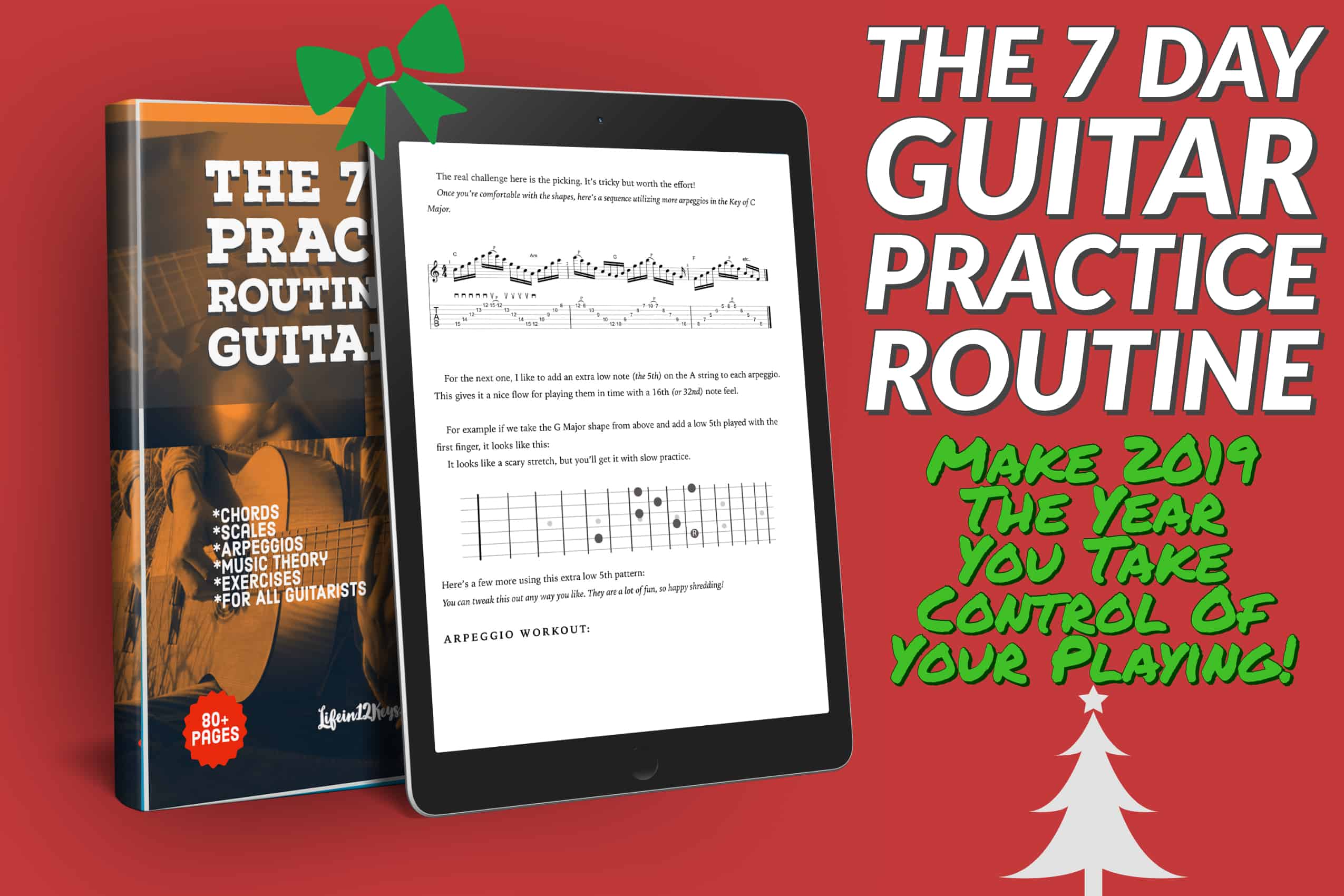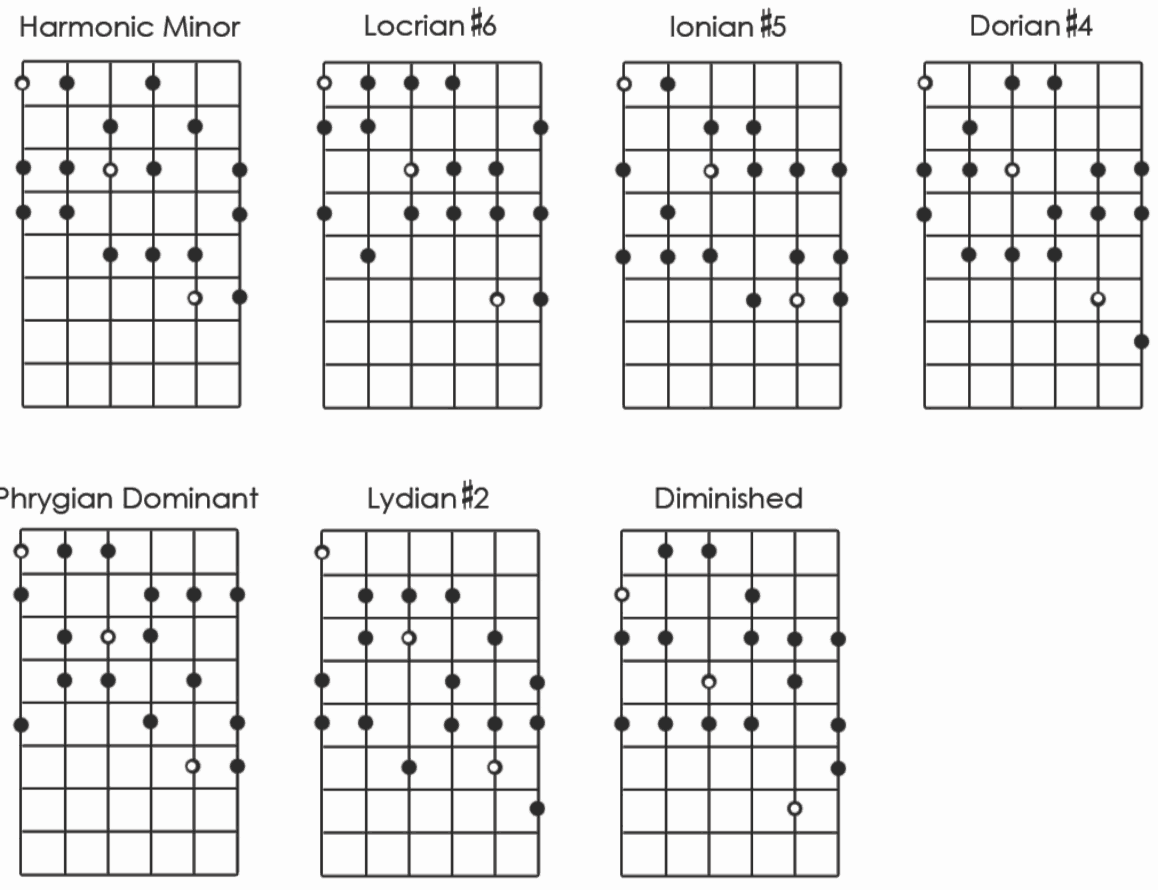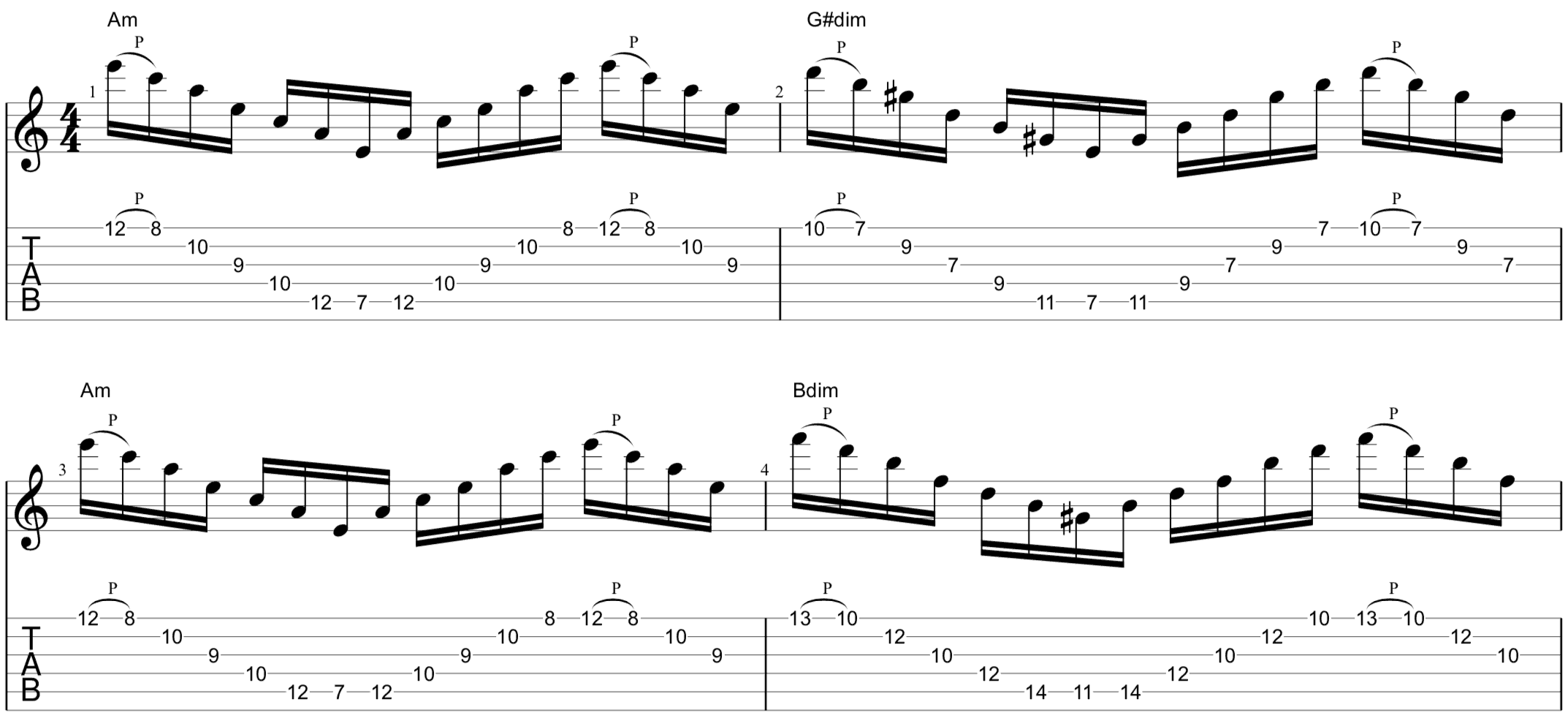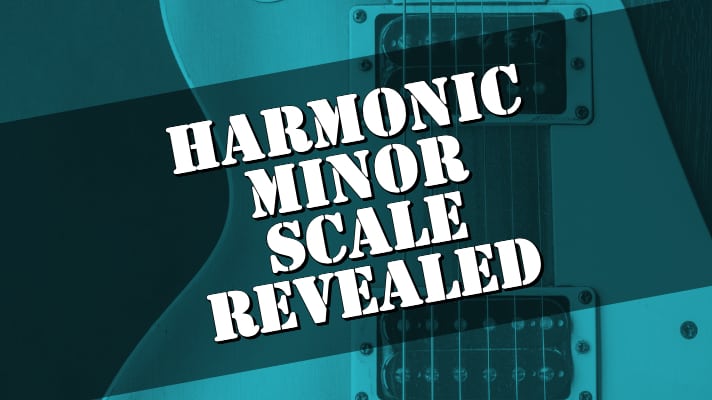I’ve been having a blast lately talking with so many guitarists about all of the things they practice and struggle with on a daily basis. When I built this website, I really wasn’t sure what it was I wanted to to do with it.
I started with varying topics that inevitably would always come back around to guitar practice routines and practical, applicable music theory that seemed to be lacking in so many online lessons and videos out there.
The 2 hottest topics that have resulted in the most traffic (and the most replies on my email subscriber list) have been Guitar Practice Routines and the way that I approach theory in a simple and easy to digest way.
I’ve been overwhelmed and humbled by the incredible sales and great feedback on my first book : The 7 Day Practice Routine for Guitarists.. so much so that it has inspired me to not only keep going with my FREE online lessons but actually start a second book!
If you haven’t checked out my first book, read some of the testimonials and info here:

The focus of “untitled guitar book #2” so far has been an expansion on music theory, particularly pertaining to chords, scales and arpeggios. After all, these are the building blocks for everything we play on the guitar!
While that first book put a lot of basic theory and useful shapes and exercises into a great 7 Day Guitar Practice Routine, my focus on this second one is to really see how far I can take each topic in depth… the results and feedback so far have been really good.
In case you missed it.. these recent free lessons are the basic direction I’m going for with this second book:
The Harmonic Minor Scale
Today I want to cover the Harmonic Minor Scale, including some shapes, harmony and practical application that I hope you will enjoy.. and of course get some real world use from in your own guitar playing.
Harmonic Minor Scale in Theory
For the sake of simplicity, let’s use the key of C Major as our starting point (parent scale) from which to extract our relative Harmonic minor.
C D E F G A B C
Remember that to find our “relative minor” we’ll go straight to the sixth degree of the scale (A).
- C
- D
- E
- F
- G
- A – Relative minor
- B
- C
Now lets build our Natural minor scale (Aeolian Mode) from A.
A B C D E F G A

To convert the natural minor to Harmonic Minor we simply raise the 7th degree 1/2 step (semi-tone).
- A
- B
- C
- D
- E
- F
- G raised to G#
- A
A Harmonic Minor:
A B C D E F G# A
Pop Quiz
Now let’s try to figure out the Harmonic Minor Scale from some other parent Major Keys.
If you’ve never fooled around with harmonic minor before, you’ll be immediately taken with the exotic almost Spanish sound.
This scale has been widely used for over 300 years by everyone from J.S. Bach to Surf Guitar pioneer Dick Dale (Check out the Pulp Fiction Soundtrack) to modern Progressive Fusion and Metal players.
It’s also widely used in Flamenco and Shred Metal genres extensively.. You would think those 2 genres don’t really go together but many of the progressions and solos in Flamenco music are eerily similar to some of the classic Metal bands.
80’s Neo-Classical Guitar
While other Rock and Metal Guitarists such as Uli Jon Roth and Randy Rhoads had used harmonic minor scales in their music, it wasn’t until the mid-1980’s that it really started to catch on thanks to Swedish guitarist Yngwie Malmsteen. If you’re like me and anywhere near my age (40-something), Yngwie was probably the first guy who brought attention to this scale for you in the Metal genre.
Yngwie took the guitar community by storm with his precise and speedy Paganini style violin runs using the harmonic minor scale almost exclusively for his first few albums. While Yngwie spawned an entire generation of imitators, his early work still stands as some of the best examples of this style of guitar playing.
Many of his songs and instrumentals centered on the harmonic minor scale for the basis of the main theme or riffs, such as “I am A Viking” from 1985’s Marching Out. (video below)
I started playing guitar in late 1987. As you can imagine, it was a really exciting time to start! So much groundbreaking guitar music out there. Guitar was at the forefront of every genre and a new generation of better, faster more knowledgeable guitarists were emerging from all over the world.
My Top 5 80’s Shred Guitar Albums:
- Jason Becker – Perpetual Burn
Really IMO, the best 80’s era instrumental guitar album ever recorded. From beginning to end this timeless classic delivers on all fronts and includes one of the best classical style counterpoint pieces ever recorded – “Air”. - Racer X – Second Heat
Paul Gilbert and Bruce Bouillet pick up where Yngwie leaves off in this Shred Metal classic. Also includes the classic instrumental “Scarified”. A must have for Shred Guitar fans. - Vinnie Moore – Mind’s Eye
A little bit of Al Di Meola and a a lot of Yngwie influence on Vinnie’s first outing. A great example of how things were progressing fast in the 80’s. - Greg Howe –Greg Howe
Maybe the best raw song-writing and composition guy of the bunch, before Greg Howe went fusion he was an 80’s shredder too. Every song on his first record holds up as a groovy, shred-rock masterpiece. - Yngwie J. Malmsteen’s Rising Force – Marching Out
The one that really started it all for Yngwie. Stellar vocals throughout by Jeff Scott Soto and arguably the best collection of Metal songs he’s ever put together in his 30+ year career.
Harmonic Minor Shapes on the Guitar
Ok, let’s get to it! There are several ways to get this new scale under your fingers all over the fretboard. Lets take a look at A Harmonic minor mapped out 3 notes-per-string:

I prefer 3 note-per-strong shapes over the old-fashioned CAGED and jazz boxes because they simply cover more fretboard and overlap nicely into the next shape or mode.
We can also create a new set of modes built around the harmonic minor scale and it’s harmony.
Remember, when it comes to modes, don’t get too hung up on the goofy names. Look, these things have been around for centuries.. there’s no sense beating yourself up trying to memorize something like “Lydian #2”. It’s not going to make you a better guitarist.
Remember, when it comes to modes, don't get too hung up on the goofy names. These things have been around for centuries.. there's no sense beating yourself up trying to memorize something like 'Lydian #2'. It's not going to make you a better guitarist.Click To Tweet What will help is if you remember where you came from diatonically (the original parent scale) and how these new modes were named based on the parent key’s modes. Let’s take a quick look..If you’re completely new to modes, check out my free guitar lesson on scales and modes, then come back here when you’ve got a handle on it..
- Harmonic Minor – Aeolian with a raised 7th.
- Locrian #6 – Remember since we started with our 6th degree of our parent scale (C Major), the second mode in A Harmonic minor will be Locrian. As you may have guessed, that G# ends up being the #6th in this new Locrian alteration. (The G# raises the 6th 1 half-step)
- Ionian #5 – Remember Ionian is synonymous with our parent Major Scale, so now were just changing the G to a G# which is the 5th of Ionian.
- Dorian #4 – You probably get the idea by now.. The Dorian mode with a raised 4th (again, G#).
- Phrygian Dominant – This is a BIG ONE. Try playing this mode over an E Major or E7 chord vamp. This is where harmonic minor really shines in all styles of guitar music. That G# becomes the Major 3rd in E.
- Lydian #2 – That G# raises the 2nd in Lydian for an awkward minor 3rd leap from the 1st and 2nd notes in the scale.
- Diminished – The biggest change occurs here because we’re actually changing the ROOT of our original (G Mixolydian) scale to a G#. The result is a really dark scale – The Diminished Scale.

You could sit down and figure out all of the notes on the neck in any Harmonic Minor Key center.. but yikes.. not only is that just a lot of unnecessary work, it makes it hard to easily move this scale from key to key. I’ve always felt modes were the easiest way to get the entire scale across the fretboard in any key. All you have to do is commit to memorizing 7 modal shapes. That’s it! In no time you’ll be writing and improvising in Harmonic minor.
Harmonic Minor Scale Chords and Harmony
You could probably stop here and have a lot of fun with the above Harmonic Minor Modes.. but let’s take our studies a bit further and check out what happens when we harmonize the whole thing!
When we change a note in any scale.. there is a trickle-down effect that spills over to other chords and arpeggios in the key.
Lets take a look at what triads we get with harmonic minor:

Now let’s look at what has changed and stayed the same from our parent (C Major Scale):
- Am – Remains unchanged.
- B dim – also unchanged.
- C Augmented – The added G# raises the 5th of C up a half step resulting in an Augmented Triad (1+3+#5).
- Dm – Remains unchanged.
- E – The G# makes the E a Major chord type.
- F – Remains unchanged.
- G# dim – A new root note and diminished triad.
Now lets add some 7ths:

When adding 7th’s, we can really start to see some drastic changes from our parent C Major/A minor scale.
- Am7 becomes A minor with a raised 7th (G#)
- Bm7b5 remains unchanged.
- CMaj7 becomes a CMaj7#5 with a raised 5th (Just like its modal counterpart Ionian #5)
- Dm7 becomes D7.
- Em7 becomes E7.
- FMaj7 the only other unchanged chord.
- G7 (From the parent C Major) becomes G#Diminished 7.
WOW! That’s some serious changes to the harmony structure from the original Major/Minor scale. Regardless of what kind of music you’re into, you can have a lot of fun with this stuff. From Jazz to straight Metal there are so many uses for it.
Some chord shapes:

Remember this is just a fraction of some of the chords you can come up with using this new scale! Fool around with it and create some of your own.
Fun with Harmonic Minor Arpeggios
You know I couldn’t resist putting in a fun little shred exercise using some 5 sting arpeggios found in A Harmonic Minor.
Jump on my Email list to get the full 2-page version and FREE lesson right to your inbox. Unsubscribe anytime!

The Diminished 7th
Undoubtedly one of the coolest things about Harmonic Minor are the Diminished 7th chords, (also known simply as diminished chords) that occur throughout the scale.
The Formula for a Diminished 7 chord = 1 + b3 + b5 + bb7
No that wasn’t a typo! I did say DOUBLE-FLAT 7th. Sure it’s the same as a diatonic 6th… but if we used the letter for the 6th the spelling would be off. *See below
In the Key of A Harmonic Minor there are 4 Diminished 7th Chords that occur naturally in the harmony:
- B Dim7 – (B D F Ab)*
- D Dim7 – (D F Ab C)*
- F Dim7 – (F Ab C E )*
- G# Dim7 – (G# B D F)
*Where Ab is the same as G#
These 4 Diminished chords occur above and beyond the other diatonic chords built on these root notes we talked about earlier in this lesson.
There are tons of interesting things happening in and around Diminished 7th chords & arpeggios. A few worth noting are:
- Any note in a Diminished 7th Chord could be considered the root.
- Any Diminished 7th chord or arpeggio can be repeated using the exact same shape every 4 frets (minor 3rd)
- Lowering any 1 note in a Diminished 7th creates a new Dominant 7th Chord on THAT new root note.
Whoa, what? Let me repeat that…
Dim7 – Dom7 Connection
Take any Diminished 7th chord shape and lower ANY note 1 half-step. The note you lowered becomes the root of a NEW Dominant 7th Chord! Try it.
G#dim7– lower the G# to G = G7
Bdim7, lower the B to Bb = Bb7
Pretty cool right? Here are a few examples of that below:

Well I hope this has taken some of the mystery out of one of the coolest and most beloved scales we can play on the guitar!
If you liked this article please let me know and consider joining our Facebook Group for Guitarists. There are some great players in there and we’re always looking for more guitarists of any skill level to hang out with.
until next time,,,
Craig
Craig Smith is a professional Guitarist, Teacher, and Writer living in Sanford, Florida. Craig has taught guitar lessons, performed 200+ gigs per year for nearly 30 years, and published 4 guitar instructional books. When he’s not gigging or writing, you may find him by the pool with his wife Celeste, 4 Chihuahuas, and a drink. 🎸



